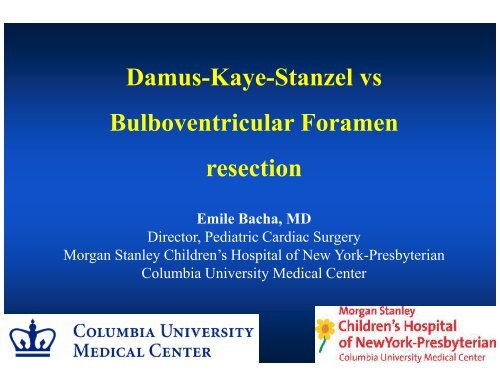Damus-Kaye-Stanzel vs Bulboventricular Foramen resection
Damus-Kaye-Stanzel vs Bulboventricular Foramen resection
Damus-Kaye-Stanzel vs Bulboventricular Foramen resection
You also want an ePaper? Increase the reach of your titles
YUMPU automatically turns print PDFs into web optimized ePapers that Google loves.
<strong>Damus</strong>-<strong>Kaye</strong>-<strong>Stanzel</strong> <strong>vs</strong><br />
<strong>Bulboventricular</strong> <strong>Foramen</strong><br />
<strong>resection</strong><br />
Emile Bacha, MD<br />
Director, Pediatric Cardiac Surgery<br />
Morgan Stanley Children’s Hospital of New York-Presbyterian<br />
Columbia University Medical Center
Frame the problem<br />
• Tricuspid atresia with d-TGA<br />
• DILV (S,L,L)<br />
• Rare forms of single V, unrestricted<br />
pulmonary blood flow and<br />
subaortic systemic obstruction
Lets agree on a few principles<br />
1. Surgical strategy largely determined by:<br />
– BVF<br />
– Semilunar valves<br />
– (aortic arch)
Lets agree on a few principles<br />
1. Surgical strategy largely determined by:<br />
– BVF<br />
– Semilunar valves<br />
– (aortic arch)<br />
2. BVF <strong>resection</strong> is not applicable during neonatal<br />
period (exposure, friable tissue)
Lets agree on a few principles<br />
1. Surgical strategy largely determined by:<br />
– BVF<br />
– Semilunar valves<br />
– (aortic arch)<br />
2. BVF <strong>resection</strong> is not applicable during neonatal<br />
period (exposure, friable tissue)<br />
Therefore, if subAS (restrictive BVF) is severe<br />
enough to warrant <strong>resection</strong>, then DKS/Norwood<br />
is necessary (palliative switch?)
Lets agree on a few principles<br />
1. Surgical strategy largely determined by:<br />
– BVF<br />
– Semilunar valves<br />
– (aortic arch)<br />
2. BVF <strong>resection</strong> is not applicable during neonatal period (exposure, friable<br />
tissue)<br />
Therefore, if subAS (restrictive BVF) is severe enough to warrant <strong>resection</strong>, then<br />
DKS/Norwood is necessary (palliative switch?)<br />
3. If there is aortic arch obstruction, Norwood
Does PA banding really increase the<br />
chances of restriction
How do you determine if a<br />
BVF is restrictive, or will be<br />
restrictive?
• a systemic outflow gradient at the subvalvular<br />
level
• a systemic outflow gradient at the subvalvular<br />
level<br />
or<br />
• a bulboventricular foramen/aortic valve<br />
diameter ratio of 1 or less
You are more likely to end up with obstruction if the BVF is small<br />
to begin with
If the aortic arch is obstructed, the BVF is more likely to be small
Patients WITHOUT aortic arch obstruction: patients who developed<br />
BVF obstruction had sign. smaller BVF index area
Conclusions (Matitiau et al)<br />
• Neonate with a BVF size index of < 2cm 2 /m 2<br />
are at high risk for developing BVF obstruction
What happens to the BVF even if<br />
you DON’T band the PA?
Modified Norwood Operation for Single Left<br />
Ventricle and Ventriculoarterial Discordance: An<br />
Improved Surgical Technique.<br />
Mosca, Bove et al<br />
Ann Thorac Surg 1997;64:1126-1132
• N=20: Although the absolute bulboventricular<br />
foramen size did increase in approximately 50%<br />
of patients, this was not predictable, and when<br />
indexed to body surface area, there was an<br />
overall decrease with time (20%)
Management strategies:<br />
DKS <strong>vs</strong> BVF <strong>resection</strong> (or other non<br />
“arch” procedures)
BVF <strong>resection</strong>
BVF <strong>resection</strong><br />
• Usually in older patients who have been banded<br />
and started out with large BVFs
BVF <strong>resection</strong>:<br />
location of the conduction system<br />
Anderson R. H. et al.; Ann Thorac Surg 1998;66:644-648
Technique of DKS (Norwood) in<br />
setting of d-TGA or l-TGA
Mosca et al, ATS 1997
Mosca et al, ATS 1997
Mosca et al, ATS 1997
Conclusion<br />
• For patients with single ventricle, unrestrictive<br />
pulmonary blood flow and an aorta arising from<br />
an outflow chamber connected to the main<br />
ventricle via a BVF (usually DILV/SLL or<br />
Tricuspid Atresia/d-TGA)
Conclusions<br />
• BVF size in the neonate is an important<br />
predictor of late obstruction<br />
• Neonate with a BVF size index of < 2cm2 /m2 • Neonate with a BVF size index of < 2cm2 /m2 are at high risk for developing BVF obstruction<br />
• Although the BVF appears to grow, its growth<br />
does not keep pace with somatic growth in most<br />
patients
Conclusion (management)<br />
• If there is AS or aortic arch hypoplasia:<br />
Norwood
Conclusion (management)<br />
• If there is AS or aortic arch hypoplasia:<br />
Norwood<br />
• If there is any evidence of subAS (restrictive<br />
• If there is any evidence of subAS (restrictive<br />
BVF): Norwood
Conclusion (management)<br />
• If there is AS or aortic arch hypoplasia:<br />
Norwood<br />
• If there is any evidence of subAS (restrictive<br />
BVF): Norwood<br />
• For patients with no AS/ao arch hypoplasia and<br />
large BVF, PAB may be an option (very rare!)




